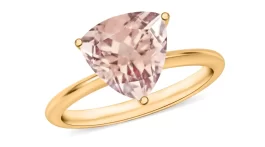Ready for the journey into the enchanting world of precious stones? Today, our voyage takes us into the heart of two stunning violet-hued gemstones—tanzanite and amethyst. Though they share a color palette, these two gems are far from twins.

Discerning their differences is not only a fantastic learning experience, but it also empowers you when shopping for these beautiful stones. We’ll explore everything from their color range to hardness, geological origins to metaphysical properties, and even how to ensure you’re buying a genuine gemstone. By the end of our journey, distinguishing between tanzanite and amethyst will be a breeze. Ready to join us? Let’s set sail!
COLOR: TANZANITE VS AMETHYST
The color of a gemstone is often the first clue to its identity. Tanzanite often displays a blend of sapphire blue and violet, while amethyst ranges from light lilac to rich, deep purple.
HARDNESS: TANZANITE VS AMETHYST
Hardness is a critical factor, especially when considering gemstones for jewelry. Amethyst, scoring seven on the Mohs hardness scale, is slightly more resistant to scratches and everyday wear than tanzanite, which scores between 6.5-7.
PHYSICAL PROPERTIES OF TANZANITE AND AMETHYST
Each gemstone has unique physical properties. For example, amethyst belongs to the trigonal crystal system, while tanzanite is orthorhombic.

PRICINGS: TANZANITE VS AMETHYST
Tanzanite generally commands a higher price than amethyst due to its rarity and demand. It is found only in Tanzania, while amethyst is more abundant, sourced from multiple locations worldwide.
TANZANITE AND AMETHYST IN JEWELRY
Both tanzanite and amethyst are popular choices for jewelry. However, the slightly greater hardness of amethyst makes it a more durable option for rings and bracelets. At the same time, tanzanite is ideally suited for earrings and pendants.
ORIGIN OF TANZANITE AND AMETHYST
Tanzanite has a single-source origin—Tanzania—making it highly prized. Amethyst, however, is abundant and found in various locations worldwide, including Brazil, Uruguay, and Morocco.
CARING FOR TANZANITE AND AMETHYST
Although both are relatively durable, amethyst’s higher hardness means it’s more wear and tear-resistant. Nevertheless, both gemstones should be handled carefully and avoid harsh chemicals or extreme temperature changes.
METAPHYSICAL PROPERTIES OF TANZANITE AND AMETHYST
On the metaphysical front, tanzanite is believed to aid in spiritual exploration and communication, while amethyst is considered a powerful and protective stone known for its capability to calm the spirit and mind.
SHAPE AND CUT: TANZANITE VS AMETHYST
Typically, tanzanite is cut into various shapes to enhance its color. At the same time, amethyst is frequently found in round and oval cuts, although other forms are also common.
AVOIDING SYNTHETIC TANZANITE AND AMETHYST
As synthetic gemstones become more common, you must ensure you buy genuine gems. Always purchase from reputable dealers, and if in doubt, seek advice from a professional gemologist.
FINAL VERDICT
And there you have it! Now you’re armed with the knowledge to distinguish between the stunning tanzanite and the gorgeous amethyst. Whether adding to your jewelry collection or buying a thoughtful gift, you can do so confidently. Remember, each gemstone has its unique story and charm—much like each one of us. So, keep exploring, learning, and, most importantly, shining!
Discover gemstone jewelry with Shop LC.





No Comment